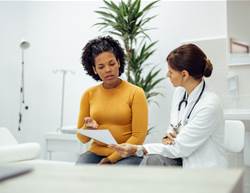Nearly one million Australian girls and women live with endometriosis at some point in their lives, according to Endometriosis Australia. The common condition can cause regular pelvic pain that can impact every area of a woman’s life, from mental health through to professional success. And many women struggle to get the help they need – on average, it takes 6.5 years to get a diagnosis.
We worked with two women's health experts to answer our top questions about endometriosis: Dr Felicity Roux, an expert in menstrual health education from Curtin Medical School, and Associate Professor Mike Armour, an expert in dysmenorrhoea from Western Sydney University.
The symptoms of endometriosis can be brutal. How can this affect women’s lives?
With endometriosis, tissue similar to the lining of the womb are found outside it, sometimes in other parts of the body. Endometriosis affects every aspect of a woman's life, and can severely impact her wellbeing and quality of life. For example:
Physical health: Pain is usually experienced as debilitating, interfering with daily life and ordinary activities, including sleeping.
Mental health: Chronic pain may lead to depressive symptoms or sadness. Where pain is either unpredictable or anticipated, women may experience anxiety.
Relationships: Pain may make a woman to withdraw from social activities, leading to isolation and loneliness. In intimate relationships, sex may be painful and affect intimacy.
Professionally: It can become difficult to sustain an on-going presence at work or a developing career when having to cope with regular bouts of pain, nausea or fatigue.
Financially: The expenses associated with treating or managing endometriosis can be high, particularly with frequent medical appointments, or investigating complementary therapies that may not necessarily be covered by health insurance.
Why is endometriosis so hard to diagnose?
- Painful periods are one of the first and most common symptoms of endometriosis.
- There is some overlap between the symptoms of endometriosis (like gastrointestinal symptoms, pelvic pain and period pain) and other causes of pelvic pain (such as irritable bowel syndrome or painful bladder syndrome). This can result in a delay in identifying endometriosis as the underlying cause of pain.
- Not all women with endometriosis necessarily experience pain, which points to a wide variability of symptoms experienced.
- Until very recently the only way to diagnose endometriosis was a laparoscopy. This is an invasive surgical procedure and so was not commonly done straight away. An expert ultrasound is now being recognised as a quicker way to diagnose some kinds of endometriosis. Research is underway for less invasive but still reliable tests.
- Stigma around periods remains a pervasive problem, which likely makes some women reluctant to discuss their painful symptoms. The impression that "this is a woman's lot in life" may factor women suffering in silence.
Is there anything women can to help themselves get diagnosed?
Definitely. However, women would need to learn the skills to do this. Here are two helpful tools. First, the Period ImPact and Pain Assessment (PIPPA) is a short five-question screening tool that can be completed online that helps young people understand if they should speak to a health professional about their symptoms.
Second, My Vital Cycles is an evidence-based ovulatory menstrual health literacy program for use in schools, sports clubs and social circles. The concepts it teaches about the cycle are backed by contemporary science. It teaches young women the knowledge and skills to know for themselves whether their cycles are healthy and gives them the confidence to work with their healthcare provider to restore good health.
How effective are endometriosis treatments?
Currently, there is no cure for endometriosis. Therefore, treatments help manage symptoms. There are different treatments, varying in their effectiveness according to the severity of each woman's condition and her response to any given treatment. Current guidelines in Australia suggest a stepwise approach, starting with:
Medication
Over-the-counter non-steroidal anti-inflammatory drugs can sometimes help mild to moderate pain but may not necessarily be sufficient for severe pain. Stronger pain medications, such as opioids, may then need to be prescribed, but these are generally not recommended for chronic pain like endometriosis.
Hormonal therapies
Hormonal therapies include the oral contraceptive pill, progestin therapies, GNRH agonists or antagonists. These can be effective for some people, however they aren’t suitable for those wanting to fall pregnant, and some people find the side effects to be really unpleasant.
Surgery
Laparoscopic surgery (see above) is the most effective treatment for most people, however even when seeing an expert endometriosis surgeon, repeat surgery may still be needed.
A hysterectomy isn’t a treatment for endometriosis itself, but those with endometriosis may also have another condition called adenomyosis, which affects the uterus itself. In those women, removing the uterus can stop the symptoms caused by their adenomyosis, but won’t remove the endometriosis itself.
Are there any complementary treatments or lifestyle changes that can also help improve symptoms?
There are a wide range of complementary therapies which can be implemented alongside the above treatments. The complementary therapy with the best evidence for improving pain is regular acupuncture. There are also some potential benefits from yoga, dietary supplements like N-Acetyl L-Cysteine (NAC) or Palmitoylethanolamide (PEA), medicinal cannabis, and changes in diet such as a low-FODMAP diet.
Always speak to your doctor about the right medications for you.
What’s the one thing you wish every woman knew about periods?
Dr Felicity Roux: “I wish every woman knew that her periods are driven by ovulation. Focusing on that unlocks a whole new level of self-understanding. It can empower women to make healthy choices and, if need be, help them co-operate with doctors from diagnosis to treatment.”
A/Prof Mike Armour: “While period symptoms are common, period pain and other period symptoms which disrupt your day-to-day life, like having to miss work or school, should always be discussed with your doctor.”









